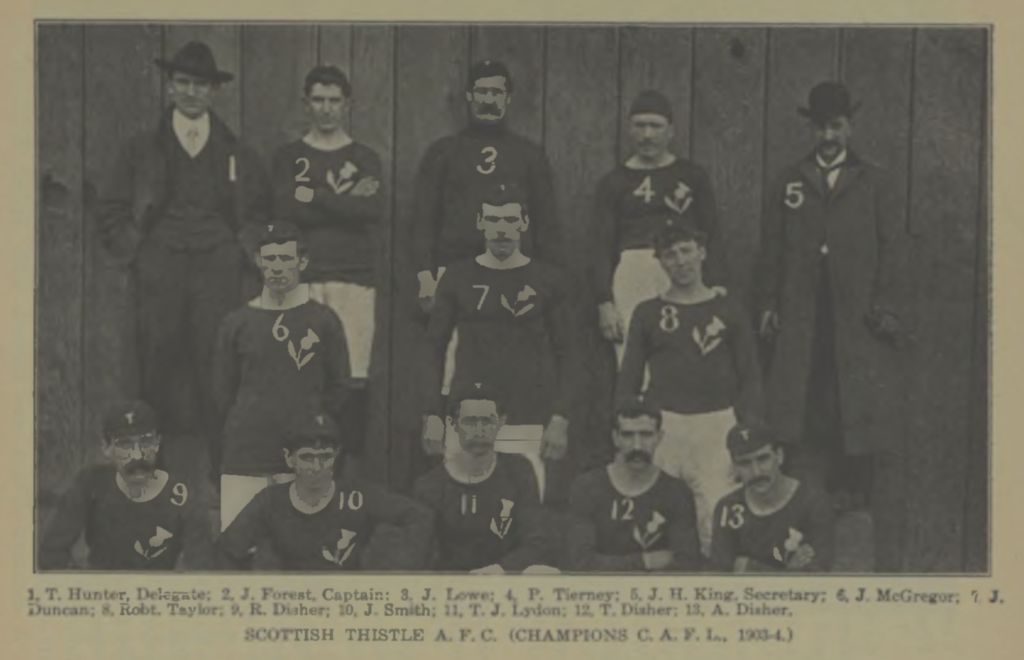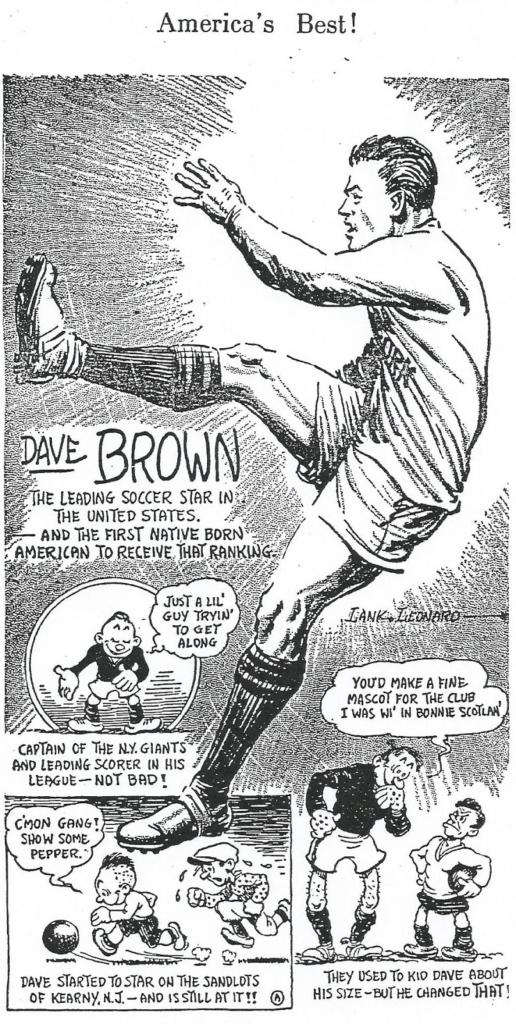
Tartan – the distinctive fabric woven for generations, tying together generations with their distinctive patterns (my father’s father is buried in the tartan of our Clan Colquhoun). Proscribed by the Dress Act of 1746, the wearing of the tartan now is an affirmation of Scottish identity. This text today is an attempt to tease out the threads woven between us that connect us, as SASH, connect our cause with that of our brothers from the Hampden Collection. I propose here to explore how Scottish diaspora studies can help us better understand the dissemination of the beautiful game, as the contested narratives, the challenge to hegemony of the Hampden Collection parallels that of SASH – like colored threads in a tartan. By identifying the pattern of the Scotch Professor, we find their cause interwoven with our own. We are cut from the same cloth. In common, we seek nothing more than truth as the antidote for the amnesia and apologetics that compromise the health of the game in both our countries.
Over 700 years ago, the Declaration of Arbroath put forth the radical notion that the people have a right to reject tyranny, a template for the Declaration of Independence. By act of Congress, April 6 is celebrated each year as Tartan Day, celebrating the “monumental achievements and invaluable contributions” made by “Americans of Scottish descent” (20 March 1998 Congressional Record – Senate). Arthur Herman neglects sport when he demonstrates How the Scots Invented the Modern World. But ye cannae ken the modern world without considering the modern game. So, what tartan threads are woven into the tapestry of US soccer?
How Scottish are we? Data from the United States Census Bureau makes it clear very many Americans identify with Scottish or Scotch-Irish ethnicity, even if those numbers continue to show some decline. Whether or not those entered either under “origins” on the most recent Census will show the number as more or less than 8 million, the true number most likely far exceeds those who know of and identify with their own Scottish ancestry.
Bagpipes and Brigadoon. Oh, and golf. Somehow the sport of the rich mythologizes itself as Scotland’s national game. Bugs Bunny against Angus MacRory represents how Americans saw Scottish games in 1948. Groundskeeper Willie might be seen as progress with cartoon stereotypes, acknowledging fitba is the game of the people. But the Simpsons character who identifies at Ellis Island as Dr. William MacDougal never identifies his former profession and his didactics restricted to hooliganism. “You call this a soccer riot?” he says in disgust over Springfield’s emerging supporter culture. Scotland’s contribution to the global game is reduced to fan violence, ignorant of and in contrast with the interweaving patterns on the pitch woven by the Scotch Professors.
The first thread, or first threads like a baby’s blanket at its birth, may be found by identifying clubs whose identities are clearly patterned on a Scottish linguistic template. Ignoring dozens of Rangers, Celtic, and Hibernian clubs across the country, not to mention clubs whose identities are local with strong concentrations of Scots. From the independent clubs identified by Mel Smith as playing association football up until 1891, one compiles a list of more than a dozen clubs across the country – from Massachusetts to California – identifying as Scottish by calling themselves Caledonians or Thistles.
Chicago (IL) Scottish Shields 1889-90
Chicago Thistles 1888-91
Hartford (CT) North Scotlands & South Scotlands 1876
Holyoke (MA) Scotia Athletics 1889
Lonsdale (RI) Thistles 1889-90
Minneapolis (MN) Thistles 1888-90
Newark (NJ) Caledonians 1886-91
New York (NYC) Caledonians 1873
New York Thistles 1884-91
Paterson (NJ) Caledonian Thistles 1883-85
Paterson Thistles 1885-91 (known as Rangers 1888)
Philadelphia (PA) Thistles 1890-91
River Point (RI) Clydes [founded as Vale of Clyde] 1885-91
St. Louis (MO) Thistles 1881-88
San Francisco (CA) Thistles 1890-91
Scranton (PA) Caledonians 1888-89
Springfield (MA) Caledonians 1890-91 (Smith 587-647)
Each club a thread to follow through the labyrinth of US soccer pioneers…
The story of the American Football Association Cup cannot be told without an appreciation for the role played by Scotch Professors. As Roger Allaway, Tom McCabe, and others have shown, the textile industry played a key role in the sport’s nascent stages, with Clark’s Our New Thread team, mostly comprised of Scots, winning the Cup its first three years. Another list of clubs with overt Scottish identities is compiled by looking simply at the champions and runners-up of the Cup. Formed in 1895 and still playing, the role of the Kearny Scots in shaping US soccer history is a key thread in the award-winning documentary Soccertown USA.
Tremendous opportunity is there for us to find out more about these clubs, their players and supporters and those early custodians of the game who helped it grow in its infancy. So much forgotten there is so much to explore and discover.

Factors that suspended the game’s growth, the Dark Ages of 1899-1905 in which no AFA Challenge Cup held, are an important thread for us to pursue at another time, but when association football came back, as socker, Scots and Scottish identifying clubs were once more at the fore. From New York’s Caledonian Club, to the Chicago Thistles, down to The Thistle Association Football Team of Cincinnati, over to the Scottish Thistle Association Football Club. “Giving exhibitions of combination never dreamed of on the Coast,” as the annual Spalding Guide said, the story of the eventual 1904 champions of the California Association Football League is the story of Scotch Professors, spreading their gospel of the beautiful game from sea to shining sea.

One thread I hope to pursue is that of the various clubs that represented individual Scottish clans. Brooklyn’s Clan Macdonald Soccer Foot Ball Club were hailed as “the premier amateur team of America for the season 1908-09” (Spalding’s p. 19) “perhaps the most popular team in Jersey or New York” (ibid., p. 23). Who were these Scotch Professors? Or Harlem’s “popular” Clan Macduff Soccer Foot Ball Team, whose group photo places tartan at the center of their identity? The stories of the Cameron and Macenzie clubs are also tales of Scotch Professors waiting to be told.
American soccer’s Golden Age was the Roaring Twenties. Glaswegian-born Archie Stark began his professional career at the age of fourteen with the Scottish-Americans of the National Association Football League in 1912-13. Serving in the War with the US Army put his career on pause, like so many footballers on both sides of the Atlantic, but Stark came back to become a goalscoring star in the thriving original American Soccer League of the 1920s.

Stark’s great goalscoring rival, “the Little Giant,” Davey Brown, hailed as the first “native-born” American “soccer star,” was of Scottish descent, raised in a community of Scottish immigrants. Perhaps, as McCabe has suggested Stark and Brown should be rated alongside Ruth and Gehrig in our national sporting narrative. Both died in Kearny. Neither of the nation’s greatest goal scorers played at the inaugural 1930 World Cup.
The Scotch Professor is not just a player, though professionalism is at the etymological source of the identity. The Scotch Professor is first and foremost one who professes or teaches the game. Although the squad lacked its two best goal scorers, a squad comprised in large part by Scottish-American professionals was led by Paisley-born Bob Millar. Beginning his career at St Mirren, he joined the Sawmakers of Philadelphia’s powerhouse Disston Athletic Association in 1912, subsequently playing for several of the era’s top clubs, his skills as a Scotch Professor evident, he became player-coach for New York’s Indiana Flooring in 1925 and was an obvious choice as coach for the USMNT in 1930, leading US to a well-deserved third place 90 years ago in Uruguay.
The team that shocked the world with a 1-0 upset against the Auld Enemy in 1950 was led by another Scotch Professor, Edinburgh-born Bill Jeffrey. Settling in Altoona, PA in 1912, he assembled a club team with his co-workers at the Pennsylvania Railroads repair shops. Penn State’s Hugo Bezdek recognized the value of a Scotch Professor on the faculty for the Nittany Lions, and he would deliver nine national titles to Happy Valley. As head coach of the 1950 World Cup side, it was a Scotch Professor who (like the Bruce at Bannockburn), masterminded a famous upset, in Belo Horizonte.
Their tradition was carried on with players imported with the North American Soccer League in the 1970s, who remained on these shores as coaches. None better represents that generation of Scotch Professors than Charlie Cooke, who coached me briefly in the late 1970s at a Memphis Rogues Soccer Camp. After retiring as a player, the Chelsea and Scotland legend co-founded Coerver Coaching. One of the masterminds of the ostensibly Dutch methodology that has had such an impact on how we teach technique is a Scotch Professor.
In the present, Stuart Sharp, the Technical Director of US Soccer’s Extended National Teams (overseeing futsal, beach, and para 7-a-side programs) grew up in Old Kilpatrick. And Glasgow native Scott Snyder is the National Director of Programs and Education for the American Youth Soccer Organization. Sharp and Snyder continue the tradition of the Scotch Professors. Formed 2019, the North American Scottish Coaches Association picks up this thread for those here and those to come as Scotch Professors continue to teach the game on fields across our country.
Just a few threads to follow… Our histories are not threadbare.
I hope by showing how our stories are interwoven, you see how the role of the Scotch Professor plays as key of a role in the birth and growth of soccer in the States as the ideas of the Scottish Enlightenment, sewn seven centuries ago with a text from Scotland that dared profess freedom.
So, with just this hint of how the character of the Scotch Professor plays such a key role in the better telling of the story of US Soccer, I would like to suggest the next time you hear an English coach scold an American child, saying “it’s not soccer, it’s football,” perhaps you’ll deconstruct the cliché and say: “your words, all the same, spare the bairn, it’s fitba for me.”
To view a video presentation of the above, see the “Scotch Professor Network” SASH Session beginning at the 37:00 mark.

The Scottish Professors! The Scotch Professor Network is doing great and needed work. Check them out at https://hampdencollection.com/scotchprofessornetwork/